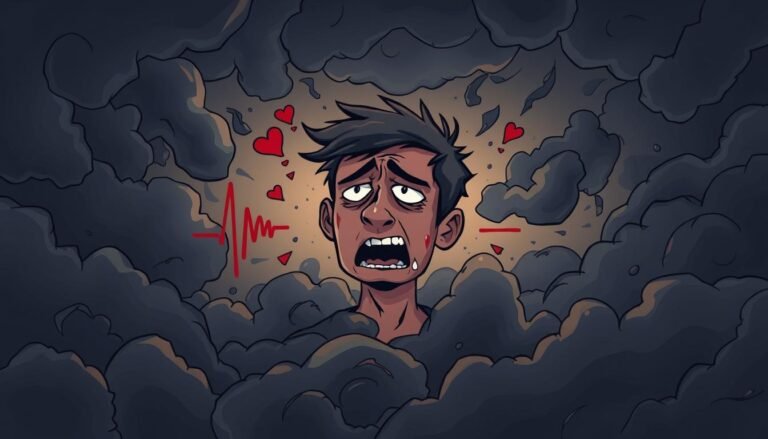Seasonal Affective Disorder (SAD): Facts & Support
Ever felt your mood dip as the days grow shorter? You’re not alone. Seasonal Affective Disorder, or SAD, affects millions of Americans each year. This form of depression follows a seasonal pattern, often striking as autumn leaves fall and lifting with spring’s first bloom.
SAD is more than just the “winter blues.” It’s a real condition that can impact daily life, causing persistent sadness, low energy, and changes in sleep and eating habits. While it’s commonly known as “winter depression,” some people experience symptoms in summer and feel better in winter.
Research shows that reduced sunlight exposure in fall and winter plays a key role in SAD development. This change can throw off the body’s production of melatonin and serotonin, affecting both sleep patterns and mood. But there’s hope. From light therapy to talking therapies and lifestyle changes, various treatment options can help manage SAD symptoms.
As we delve deeper into Seasonal Affective Disorder, we’ll explore its types, symptoms, causes, and ways to cope. Whether you’re dealing with SAD or supporting someone who is, understanding this condition is the first step toward brighter days.
Understanding Seasonal Affective Disorder (SAD)
Seasonal Affective Disorder (SAD) is a type of depression that follows the seasons. It hits people hard in winter, when days are short and sunlight is rare. Symptoms include feeling sad, having low energy, and losing interest in things you used to enjoy.
Definition and prevalence
SAD is more than just feeling down in winter. It’s a serious condition that affects many. In the US, about 5% of adults deal with SAD, with symptoms lasting 4-5 months each year. Women and younger adults are more likely to get it.
Types of SAD: Winter-pattern and Summer-pattern
Winter-pattern SAD is the most common. It starts in late fall or early winter and ends in spring. Symptoms include sleeping too much, eating too much, gaining weight, and feeling isolated.
Summer-pattern SAD is less common. It starts in late spring or early summer and ends in fall. Symptoms include trouble sleeping, losing appetite, losing weight, and feeling anxious.
Distinguishing SAD from “holiday blues”
SAD is different from the “holiday blues.” It’s linked to daylight changes, not just holidays. It messes with your body’s clock and changes serotonin and melatonin levels. These changes affect how you feel and sleep.
Unlike holiday stress, SAD symptoms are severe and last for months. They can really disrupt your daily life.
Recognizing the Signs and Symptoms
Seasonal Affective Disorder (SAD) shows different symptoms based on the season. Knowing these signs is key to catching it early and managing it well.
Common Symptoms of Depression in SAD
SAD symptoms are similar to those of clinical depression. People often feel sad all the time, lose interest in things they used to enjoy, and have trouble focusing. They might feel very tired and struggle with mood swings, from being irritable to anxious.
Specific Symptoms of Winter-pattern SAD
Winter-pattern SAD brings its own set of challenges. People might sleep too much but still feel very tired. They often want to eat more, especially carbs, which can lead to weight gain. Feeling like staying indoors and avoiding social activities is common during the cold months.
Specific Symptoms of Summer-pattern SAD
Summer-pattern SAD is less common but has its own symptoms. It often causes trouble sleeping, like insomnia. Unlike winter SAD, people might eat less and lose weight. They can also feel more irritable and restless.
| Symptom | Winter-pattern SAD | Summer-pattern SAD |
|---|---|---|
| Sleep | Oversleeping | Insomnia |
| Appetite | Increased, carb cravings | Decreased |
| Weight | Gain | Loss |
| Energy | Low, fatigue | Agitation |
| Social behavior | Withdrawal | Irritability |
Spotting these symptoms early can help get the right treatment sooner. This can greatly improve life during tough seasons.
Causes and Risk Factors of SAD
Seasonal Affective Disorder (SAD) comes from a mix of biological and environmental factors. The main cause is less sunlight in winter. This affects our body’s clock and hormone levels.
Another key factor is serotonin imbalance. Studies suggest people with SAD might have more serotonin transporter protein in winter. This could lead to lower serotonin levels, causing depression.
Melatonin production also plays a part in SAD. Darkness makes more melatonin, causing sleepiness and tiredness. This messes up our sleep-wake cycle.
Genetics are also important in SAD. If you have a family history of depression, you’re more likely to get SAD. Young adults are at higher risk, and even kids and teens can get it.
Where you live affects SAD too. It’s more common in places far from the equator. This is because there’s less sunlight in winter.
Vitamin D deficiency might also play a role. Not enough sunlight can lead to low vitamin D levels. This can make SAD symptoms worse.
| Risk Factor | Impact |
|---|---|
| Gender | SAD is diagnosed 4 times more often in women than men |
| Age | Higher risk in younger adults |
| Family History | Increased risk with family history of depression |
| Location | Higher prevalence in regions far from the equator |
Diagnosis and Assessment of SAD
Figuring out Seasonal Affective Disorder (SAD) needs a close look at symptoms and their pattern. Doctors use certain rules to spot this condition. It hits about 5% of adults in the U.S. and lasts for 40% of the year.
Diagnostic criteria for SAD
Doctors check for depressive episodes that happen in certain seasons for two years in a row. These episodes must be more common in those seasons. SAD is more common in places farther from the equator, among the young, and in women.
Professional evaluation process
Getting a mental health check is key to diagnosing SAD. This might include a physical check-up, blood tests, and questionnaires. Doctors use tools to see how bad the symptoms are and how they affect daily life.
Importance of ruling out other conditions
It’s important to rule out other mental health issues or medical problems that could cause similar symptoms. SAD often happens in people with other mental health conditions like depression or anxiety. Getting the right diagnosis early is crucial for treating SAD well.
Source Links
- Overview – Seasonal affective disorder (SAD)
- Seasonal Affective Disorder (SAD): Background, Pathophysiology, Epidemiology
- What is Seasonal Affective Disorder (SAD)?
- Seasonal affective disorder (SAD)
- Steps to keep your mood and motivation steady throughout the year-Seasonal affective disorder (SAD) – Symptoms & causes – Mayo Clinic
- How to Recognize the Signs of Seasonal Affective Disorder (SAD)
- Seasonal Affective Disorder
- Chestnut Health Systems
- Seasonal Depression (Seasonal Affective Disorder)
- Seasonal Affective Disorder SAD
- Seasonal Affective Disorder (SAD)
- Seasonal Affective Disorder
- Steps to keep your mood and motivation steady throughout the year-Seasonal affective disorder (SAD) – Diagnosis & treatment – Mayo Clinic








